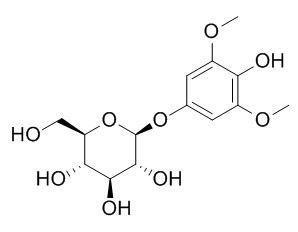Koaburaside
Koaburaside exhibits antioxidant activity with an IC50 value of 9.0μM, it shows weak inhibitory activity against influenza A neuraminidase. Koaburaside may have anti-allergic inflammatory activity, it can suppress histamine release from mast cells.
Inquire / Order:
manager@chemfaces.com
Technical Inquiries:
service@chemfaces.com
Tel:
+86-27-84237783
Fax:
+86-27-84254680
Address:
1 Building, No. 83, CheCheng Rd., Wuhan Economic and Technological Development Zone, Wuhan, Hubei 430056, PRC
Providing storage is as stated on the product vial and the vial is kept tightly sealed, the product can be stored for up to
24 months(2-8C).
Wherever possible, you should prepare and use solutions on the same day. However, if you need to make up stock solutions in advance, we recommend that you store the solution as aliquots in tightly sealed vials at -20C. Generally, these will be useable for up to two weeks. Before use, and prior to opening the vial we recommend that you allow your product to equilibrate to room temperature for at least 1 hour.
Need more advice on solubility, usage and handling? Please email to: service@chemfaces.com
The packaging of the product may have turned upside down during transportation, resulting in the natural compounds adhering to the neck or cap of the vial. take the vial out of its packaging and gently shake to let the compounds fall to the bottom of the vial. for liquid products, centrifuge at 200-500 RPM to gather the liquid at the bottom of the vial. try to avoid loss or contamination during handling.
Vet World.2023, 16(3):618-630.
Korean Herb. Med. Inf.2020, 8(2):205-213
Molecules.2020, 25(23):5609.
Molecules.2023, 28(8):3490.
Nutrients.2018, 10(12):E1998
J of Liquid Chromatography & Related Technologies2024, 47(1-5):14-25.
Horticulture, Environment, and Biotechnology2025, 66:729-739.
Korean Herb. Med. Inf.2020, 8(2):243-254.
Am J Chin Med.2016, 44(6):1255-1271
Am J Chin Med.2015, 30:1-22
Related and Featured Products
Nat Prod Commun. 2013 Feb;8(2):181-2.
Phenolic glycosides from Lindera obtusiloba and their anti-allergic inflammatory activities.[Pubmed:
23513723]
METHODS AND RESULTS:
Eight phenolic glycosides, tachioside (1), isotachioside (2), Koaburaside (3), 2,6-dimethoxy-4-hydroxyphenyl-1-O-beta-D-glucopyranoside (4), 4,6-dihydroxy-2-methoxyphenyl-1-O-beta-D-glucopyranoside (5), a mixture of erigeside C (6a) and salidroside (6b), and 6-hydroxyphenyl)-1-O-beta-D-glucopyranoside (7) were isolated from the stems of Lindera obtusiloba Blume. The structures of the isolates were determined by 1H-, 13C-NMR, COSY, HMQC, and HMBC spectroscopy. To evaluate their anti-allergic inflammatory activities, the inhibitory effects of isolates (1-7) on histamine release and on the gene expressions of tumor necrosis factor (TNF)-a and interleukin (IL)-6 were examined using human mast cells; previous studies have reported that TNF-alpha and IL-6 release from mast cells is positively related to the severity of allergic symptoms.
CONCLUSIONS:
Of the tested compounds, Koaburaside (3), 2,6-dimethoxy-4-hydroxyphenyl-1-O-beta-D-glucopyranoside (4), and (6-hydroxyphenyl)-1-O-beta-D-glucopyranoside (7) suppressed histamine release from mast cells as compared with gallic acid (positive control). In particular, 6-hydroxyphenyl)-1-O-beta-D-glucopyranoside (7) attenuated the gene expressions of the proinflammatory cytokines TNF-alpha and IL-6 in human mast cells.
J Asian Nat Prod Res. 2011 Jun;13(6):575-80.
Phenolic compounds from Eurycorymbus cavaleriei.[Pubmed:
21623524 ]
METHODS AND RESULTS:
Three new phenolic compounds, eurycorymboside A (1), eurycorymboside B (6), and eurycorymbic acid (8), were isolated from the stem part of Eurycorymbus cavaleriei (Sapindaceae) along with five known phenolic compounds, glucosyringic acid (2), vanillic acid 4-O-β-d-glucoside (3), Koaburaside (4), tachioside (5), and 4-hydroxy-3,5-bis(3-methyl-2-butenyl)benzaldehyde (7). The structures were established on the basis of spectral analysis. The antioxidant activities of compounds 1-6 were evaluated by the 1,1-diphenyl-2-picrylhydrazyl-free radical scavenging assay.
CONCLUSIONS:
Compound 4 exhibited antioxidant activity with an IC(50) value of 9.0 μM. Compound 4 also showed weak inhibitory activity against influenza A neuraminidase.



